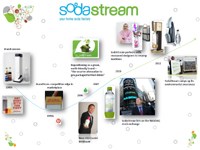SodaStream claims back marketshare through reinvention
History
SodaStream's history in South Africa dates back to the 1960s. It supposedly gained a lot of traction in the 1980s as the first and only home carbonation system on the market. By letting one mix one's own flavoured fizzy drink at home, SodaStream offered customers a novel, technologically-advanced experience.
The early 1990s saw a wide variety of new beverages introduced to the country and competition within this market exploded, which in turn impacted SodaStream's popularity. It struggled to reinvent the home carbonation experience for the consumer, and no longer seemed exciting to its users. Only now, after repositioning the brand, there is said to be an increased interest in SodaStream again.
Repositioning
The repositioning of SodaStream came about when the Fortissimo Fund bought out the company in 2006 and brought new momentum to the brand. Under CEO (and ex-Nike executive), Daniel Birnbaum's dynamic leadership, the company repositioned itself as an environmentally-friendly brand, and has enjoyed renewed business confidence after listing on the Nasdaq stock exchange in November 2010. With the backing of international investors, SodaStream South Africa is said to be tapping into a more active global innovation pipeline and taking global successes and implementing them at a local level.
All of the local SodaStream campaigns incorporate its new 'green' repositioning, tagged as 'the smarter alternative to bottled beverages', because it supposedly doesn't cause as much environmental harm as plastic bottled beverages. With marketing campaigns focused on caring for the earth, coupled with new look machines, the SodaStream story presents a unique brand/marketing case study.
Key challenges
The initial outlay in investing in a SodaStream drinks maker is quite high, with a standard machine costing around R399 and flavoured syrups retailing at R39.99, which means there is a relatively high barrier to entry.
Because of this, it is focused on developing its customer-base. One such example is a pilot project with Spaza shop owners in Soweto. The company provided owners with a starter pack, which included the essentials to make carbonated beverages, and Spaza owners could therefore set their own price per cup for their customers. This not only increased brand awareness, but also helped to target a well-responding market.
The brand also experienced very tough trading conditions over 2009 and 2010, but concentrating on growing its trade support through creative below the line in-store promotions has subsequently resulted in increased consumer take-off at store level. SodaStream's South African market is relatively small compared to its international counterparts, so budget has to be spent wisely on clever marketing tactics, which will be increased in 2012. Currently, the South African household penetration is around the 300 000 mark.
Future of the brand
The brand has undergone massive changes and turnarounds in the last few years and constant improvements as a direct response to its customers' needs have ensured that the brand attracts renewed vigour. The machine ranges have stayed up-to-date via aesthetically driven designs and improved functionality.
2012 will see the introduction of next-generation machines, offering the consumer an advanced kitchen appliance experience. By constantly offering customers added-value with its range of 60+ flavoured syrups, new products and machines, the brand promises to remain on the radar.















